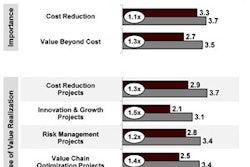
We’re on the cusp of the most diverse work environment that the world has ever seen. By 2020, there will be five different generations working together—each with different skills, experiences, work habits, and motivations. More of these workers will be freelancers and long-term contractors. All of this is unprecedented and represents a major opportunity for productivity, talent development and employee engagement. But if you’re like most companies, you’re not prepared for it. And here are five reasons why:
You’re out of Touch
Most companies recognize that today’s workforce is markedly different than it was ten, five, even three years ago. But according to Workforce 2020, a sweeping global survey of more than 5,400 executives and employees in 27 countries conducted by the Oxford Economics Group, they don’t understand how it differs—and what makes employees tick.
At the end of the day, gyms and free yogurt don’t matter. When it comes to benefits, today’s workers care more about getting paid than looking good or getting fed. According to Workforce 2020, competitive compensation was the most important attribute of a job to two-thirds of respondents—20 percent higher than the next highest benefit. Retirement plans, flexibility and time off ranked well ahead of amenities such as fitness centers, daycare and subsidized food.
You’re Losing the Skills Competition
If compensation is what motivates employees, what they’re most afraid of is losing money as a result of insufficient skills, knowledge and keeping up with the latest technologies. “Becoming obsolete” is the most popular concern for today’s worker, twice as concerning as being laid off. And few companies are doing anything about it.
The need for skills like analytics and programming/development will grow sizably over the next three years, but less than half of employees expect to be proficient in most of these areas in those 36 months.
Further, less than half of employees surveyed as part of Workforce 2020 say their company provides ample training on the technology they need, and less than one-third say their company makes the latest technology available to them.
You’re Confused by Millennials
By 2020, Millennials will represent more than 75 percent of the workforce. As the single largest and most savvy workgroup, Millennials represent a significant opportunity. Companies that can excite them about work, train them to fill in gaps on experience and adapt to their style of working can build a workforce that can successfully execute on the objectives of today and adapt to drive advantage for the business of tomorrow. But most can’t, because they don’t really understand them.
Millennials certainly are unique. They are wired, or rather unwired, differently than other generations. They are technologically savvy and are transforming traditional thinking on how and what information we share; how we view brands; how we buy and consume; and how we work.
But as uncovered in Workforce 2020, they aren’t all that different from their non-Millennial coworkers when it comes to workplace priorities.
For both groups, compensation rules, with 68 percent of Millennials and 64 percent of non-Millennials citing it as an “important” or “very important” benefit. And 41 percent of Millennials and 38 percent of non-Millennials say higher compensation would increase their loyalty and engagement with the company.
Millennials prioritize meeting career goals (35 percent), meeting income goals (32 percent), and meeting goals for advancement (29 percent), while non-Millennials prioritize corporate values that match their own (30 percent), achieving work/life balance (31 percent), and meeting income goals (30 percent).
And contrary to popular thinking, Millennials are no more likely than non-Millennials to leave their jobs in the next six months.
It’s Lonely at the Top
Building a business requires a clear vision and strong leadership that can inspire employees to make it a reality. But according to Workforce 2020, most companies are staring over the leadership cliff—and are about to fall off. Only 31percent of executives interviewed say that when a person with key skills leaves they fill the role from within the organization. And less than half indicate their leadership has the skills to effectively manage talent or inspire and empower employees.
And perhaps most troubling, almost half of executives surveyed say their plans for growth are being hampered by lack of access to the right leaders.
You Need New Tools
As the economy continues to move to a state where nearly everything can be delivered as a service, companies are increasingly tapping external expertise and resources they need, as they need them, to fill skills and resource gaps and to accommodate rapidly changing business and customer demands. That means more temporary staff, more consultants and SOW workers, and even “crowd-sourced” projects.
This is changing the nature of employment and requires a new approach to HR. To really optimize their workforce, companies need a comprehensive and flexible strategy that is fully integrated with all other business processes. And they need systems that allow them to engage all of their workers—both permanent and temporary staff, out of the gate and on the fly—in new and innovative ways to ensure they have the right people in the right roles at the right times to deliver on their goals.
But as revealed in Workforce 2020, most companies lack both. While over half (53 percent) of executives say workforce development is a key differentiator for their firm, they do not have the tools and organization to back it up.
Just 38 percent say they have ample data about the workforce to understand their strengths and potential vulnerabilities from a skills perspective, and 39 percent say they use quantifiable metrics and benchmarking as part of their workforce development strategy. And only 42 percent say they know how to extract meaningful insights from the data available to them.
But it’s not all doom and gloom. When it comes to preparing for the future of work, knowledge is power. And the power is in your hands. Tomorrow’s workforce will be more diverse and work differently. Start by understanding this. Then develop new strategies that support this diversity. And embrace emerging technologies that foster new levels of employee engagement and collaboration to drive them.
In doing so, you can build a workforce that can drive your business today and lead you to a promising future.




















